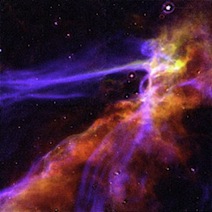The black hole Cygnus X-1 is revealing new details about its vicinity. The chaotic region is threaded by strong magnetic fields.
Cygnus X-1 was the first black hole discovered by astronomers, in 1964. It is part of an X-ray binary located 6,000 light-years away from the Sun: it is about 8.7 times the mass of the Sun, and it is closely orbited by a supergiant variable star. The black hole is sucking in gas from its companion star, heating it up to the point it emits high energy X-rays and gamma-rays.

Philippe Laurent, CEA Saclay, France, and colleagues made the discovery using the Ibis telescope onboard ESA’s INTEGRAL satellite. For the first time, the measurements revealed the presence of polarized light originating in the black hole’s immediate surroundings. This provides critical insight into how Cygnus X-1 behaves.
In space, light can vibrate in any direction. Under some circumstances (when passing through matter, for example), light can get polarized: it will vibrate in only one direction. Astronomers constantly observed the black hole over the course of 7 years, focusing on the corona of Cygnus X-1, roughly about 800 kilometers in diameter. Thanks to these observations, astronomers now know that this chaotic region surrounding Cygnus X-1 has a strong magnetic field.
INTEGRAL also reveals that these highly structured magnetic fields are forming an escape tunnel: they are strong enough to tear away particles from the black hole’s gravitation, focusing them into a jet away from it. As a result, the gamma-ray radiation coming from them is polarized: this is what the team observed.
Jets around black holes have already been observed many times, but without enough details to know how they are formed. Since the phenomenon is observed so close to the black hole’s event horizon, astrophysicists could learn a lot about the physics close in and the properties of the black hole itself.
The team detailed their findings online March 24 in the journal Science.
